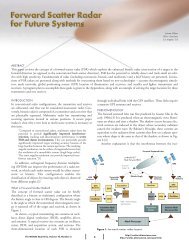Comparing Blast Pressure Variations of Lead Primers - Weapon ...
Comparing Blast Pressure Variations of Lead Primers - Weapon ...
Comparing Blast Pressure Variations of Lead Primers - Weapon ...
Create successful ePaper yourself
Turn your PDF publications into a flip-book with our unique Google optimized e-Paper software.
in the news...<br />
Members <strong>of</strong> the 36th Communications Squadron and civilian contractors<br />
use a crane to erect an instrument landing system at Andersen<br />
Air Force Base, Guam, in 2009. Officials at the Electronic Systems<br />
Center issued a contract award Aug. 12, 2011, for a deployable<br />
instrument landing system to provide a leaner system that will be<br />
more easily transportable and require less personnel to set up.<br />
(Courtesy photo)<br />
to get this effort started," said Col. Jimmie Schuman, Aerospace<br />
Management Systems Division director. "My team is looking<br />
forward to getting the system developed, tested and fielded as<br />
quickly as possible."<br />
SOURCE: http://www.af.mil/news/story.asp?id=123268992<br />
OFFICIALS CONDUCT STUDY OF AIRCRAFT OXYGEN<br />
GENERATION SYSTEMS<br />
Master Sgt. Amaani Lyle, Air Force Public Affairs Agency<br />
Air Force <strong>of</strong>ficials continue to conduct an Aircraft Oxygen Generation<br />
study, with members <strong>of</strong> the Air Force Scientific Advisory Board<br />
taking the leading role. Secretary <strong>of</strong> the Air Force Michael Donley<br />
directed the quick look study in the wake <strong>of</strong> recent F-22 Raptor<br />
incidents. Officials seek to identify a common thread among the<br />
incidents and will report their findings to senior Air Force leaders to<br />
help prevent such incidents from occurring in the future.<br />
In a July 13 memorandum to the secretary <strong>of</strong> defense, Secretary<br />
Donley noted that pilots flying the F-22 have reported in-flight,<br />
physiological events at a rate three times higher than crews from<br />
other similar aircraft. The symptoms are similar to those resulting<br />
from an inadequate oxygen supply which affected the performance<br />
<strong>of</strong> the pilots experiencing them in varied ways. "The Air Force takes<br />
flying-related incidents seriously. We met with leaders, operators<br />
and maintainers in the F-22 community to talk about the Scientific<br />
Advisory Board's oxygen generation study," said Lt. Gen. "Hawk"<br />
Carlisle, the deputy chief <strong>of</strong> staff for Operations, Plans and Requirements,<br />
Headquarters U.S. Air Force. "As part <strong>of</strong> the meeting we<br />
were able to provide the latest information on the status <strong>of</strong> the study<br />
and address their concerns regarding a timely return to fly."<br />
"This board is the secretary's brain trust," said Lt. Col. Matthew<br />
The WSTIAC Journal, Volume 11, Number 2 8<br />
Zuber, the Air Force SAB executive director. "It utilizes the nation's<br />
best scientists and engineers to advise Air Force senior leadership on<br />
science and technology issues." The SAB, composed <strong>of</strong> special government<br />
employees, works with Air Force <strong>of</strong>ficials to conduct three<br />
to five studies per year and advises the secretary and the chief <strong>of</strong> staff<br />
on the findings, Zuber said. Zuber added the Air Force has expanded<br />
the scope <strong>of</strong> the scientific investigation beyond the F-22 to<br />
include such platforms as the F-35 Lightning II, T-6A Texan II, F-16<br />
Fighting Falcon and the A-10 Thunderbolt II. The study has incorporated<br />
extensive ground testing and limited flight testing as well.<br />
The SAB study panel investigation is supported by the F-22<br />
System Program Office, the Air Force Safety Center, industry partners,<br />
Naval Air Systems Command and Air Force Research Labs.<br />
"We're all in the same room and not holding back any effort to<br />
determine whether these events are related to hypoxia, air contaminants<br />
or other factors," Zuber said, adding that no possibilities have<br />
been eliminated. This particular investigation, Zuber explained,<br />
involves a strong fact-finding analysis with deliberation among a<br />
cross-section <strong>of</strong> experts.<br />
The study will benefit from technical data generated by flight<br />
test activities conducted at Edwards Air Force Base, Calif., laboratory<br />
tests conducted by Air Force Research Labs, and contractor personnel,<br />
he said. "The zero-risk solution is not to fly, and that's not<br />
a long-term option; it's an inherently dangerous business to fly and<br />
fight wars," Zuber said. "We want to make sure we mitigate risks to<br />
a level that's appropriate for the urgency <strong>of</strong> the mission."<br />
The SAB AOG study plans to provide the Air Force secretary<br />
and Air Force chief <strong>of</strong> staff interim reports prior to the final report<br />
projected for later this fall. Once complete, the product will be<br />
releasable to the general public. Until the report is submitted, it<br />
would be inappropriate to speculate on potential outcomes <strong>of</strong> the<br />
study, Zuber said.<br />
SOURCE: http://www.af.mil/news/story.asp?id=123268093<br />
ARMY ANNOUNCES GROUND COMBAT VEHICLE<br />
CONTRACTS<br />
Office <strong>of</strong> the Assistant Secretary <strong>of</strong> Defense Public Affairs<br />
The Army announced today the award <strong>of</strong> contracts to BAE<br />
Systems Land and Armaments, L.P., <strong>of</strong> Troy, Mich., for $449.9 million,<br />
and General Dynamics Land Systems, Inc., <strong>of</strong> Sterling<br />
Heights, Mich., for $439.7 million, for the Ground Combat Vehicle<br />
program technology development phase. These contractors have<br />
been selected to develop competitive, affordable and executable<br />
designs for a new Army Infantry Fighting Vehicle, or IFV, over the<br />
next 24 months.<br />
The contract awards follow the Department <strong>of</strong> Defense's formal<br />
approval <strong>of</strong> the Ground Combat Vehicle, or GCV, program to enter<br />
the technology development phase. Approval <strong>of</strong> this first major<br />
milestone builds on months <strong>of</strong> ongoing collaboration between the<br />
Army and the Office <strong>of</strong> the Undersecretary <strong>of</strong> Defense for Acquisition,<br />
Technology and Logistics, to successfully develop, build and<br />
field an affordable, effective and suitable IFV. "The Army enthusiastically<br />
welcomes the formal launch <strong>of</strong> the Ground Combat Vehicle<br />
program, which will provide much needed protection and<br />
mobility to soldiers in combat," said Secretary <strong>of</strong> the Army John<br />
McHugh. "Given the economic environment the nation currently<br />
http://wstiac.alionscience.com<br />
http://wstiac.alionscience.com/quarterly




